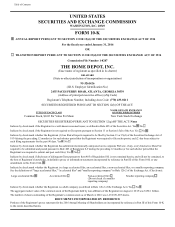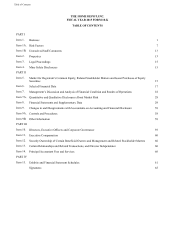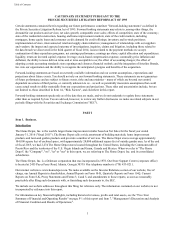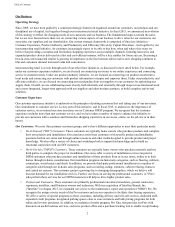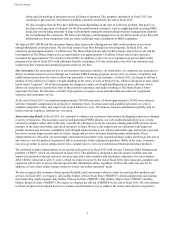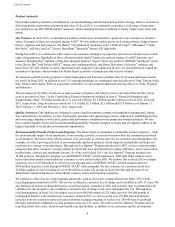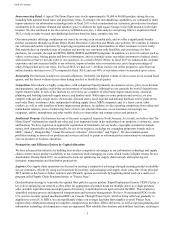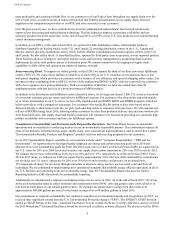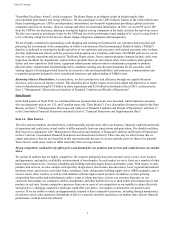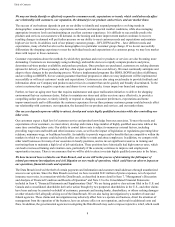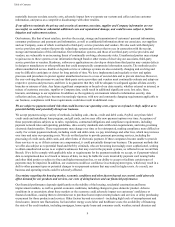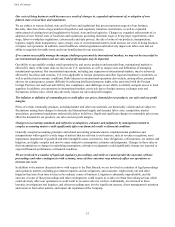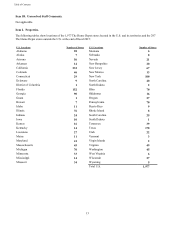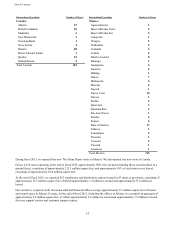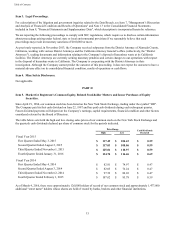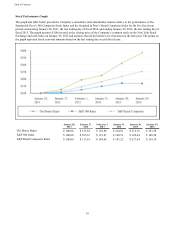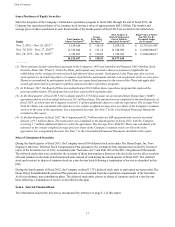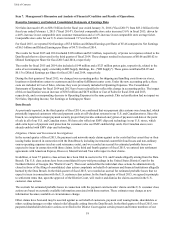Home Depot 2015 Annual Report Download - page 10
Download and view the complete annual report
Please find page 10 of the 2015 Home Depot annual report below. You can navigate through the pages in the report by either clicking on the pages listed below, or by using the keyword search tool below to find specific information within the annual report.Table of Contents
8
We may not timely identify or effectively respond to consumer needs, expectations or trends, which could adversely affect
our relationship with customers, our reputation, the demand for our products and services, and our market share.
The success of our business depends in part on our ability to identify and respond promptly to evolving trends in
demographics; consumer preferences, expectations and needs; and unexpected weather conditions, while also managing
appropriate inventory levels and maintaining an excellent customer experience. It is difficult to successfully predict the
products and services our customers will demand. As the housing and home improvement market continues to recover,
resulting changes in demand will put further pressure on our ability to meet customer needs and expectations and maintain
high service levels. In addition, each of our primary customer groups – DIY, DIFM and Pro – have different needs and
expectations, many of which evolve as the demographics in a particular customer group change. If we do not successfully
differentiate the shopping experience to meet the individual needs and expectations of a customer group, we may lose market
share with respect to those customers.
Customer expectations about the methods by which they purchase and receive products or services are also becoming more
demanding. Customers are increasingly using technology and mobile devices to rapidly compare products and prices,
determine real-time product availability and purchase products. Once products are purchased, customers are seeking alternate
options for delivery of those products, and they often expect quick and low-cost delivery. We must continually anticipate and
adapt to these changes in the purchasing process. We have implemented programs like BOSS, BOPIS and direct fulfillment,
and are rolling out BODFS, but we cannot guarantee that these programs or others we may implement will be implemented
successfully or will meet customers’ needs and expectations. Customers are also using social media to provide feedback and
information about our Company and products and services in a manner that can be quickly and broadly disseminated. To the
extent a customer has a negative experience and shares it over social media, it may impact our brand and reputation.
Further, we have an aging store base that requires maintenance and space reallocation initiatives to deliver the shopping
environment that our customers desire. Failure to maintain our stores and utilize our store space effectively, to provide a
compelling online presence, to timely identify or respond to changing consumer preferences, expectations and home
improvement needs and to differentiate the customer experience for our three primary customer groups could adversely affect
our relationship with customers, our reputation, the demand for our products and services, and our market share.
Our success depends upon our ability to attract, develop and retain highly qualified associates while also controlling our
labor costs.
Our customers expect a high level of customer service and product knowledge from our associates. To meet the needs and
expectations of our customers, we must attract, develop and retain a large number of highly qualified associates while at the
same time controlling labor costs. Our ability to control labor costs is subject to numerous external factors, including
prevailing wage rates and health and other insurance costs, as well as the impact of legislation or regulations governing labor
relations, minimum wage, or healthcare benefits. An inability to provide wages and/or benefits that are competitive within the
markets in which we operate could adversely affect our ability to retain and attract employees. In addition, we compete with
other retail businesses for many of our associates in hourly positions, and we invest significant resources in training and
motivating them to maintain a high level of job satisfaction. These positions have historically had high turnover rates, which
can lead to increased training and retention costs, particularly if the economy continues to improve and employment
opportunities increase. There is no assurance that we will be able to attract or retain highly qualified associates in the future.
We have incurred losses related to our Data Breach, and we are still in the process of determining the full impact of
related government investigations and civil litigation on our results of operations, which could have an adverse impact on
our operations, financial results and reputation.
The Data Breach involved the theft of certain payment card information and customer email addresses through unauthorized
access to our systems. Since the Data Breach occurred, we have recorded $161 million of pretax expenses, net of expected
insurance recoveries, in connection with the Data Breach, as described in more detail in Item 7, "Management’s Discussion
and Analysis of Financial Condition and Results of Operation" and Note 13 to the Consolidated Financial Statements
included in Item 8, "Financial Statements and Supplementary Data". We are facing putative class actions filed in the U.S. and
Canada and a consolidated shareholder derivative action brought by two purported shareholders in the U.S., and other claims
have been and may be asserted on behalf of customers, payment card issuing banks, shareholders, or others seeking damages
or other related relief, allegedly arising out of the Data Breach. We are also facing investigations by a number of state and
federal agencies. These claims and investigations may adversely affect how we operate our business, divert the attention of
management from the operation of the business, have an adverse effect on our reputation, and result in additional costs and
fines. In addition, the governmental agencies investigating the Data Breach may seek to impose injunctive relief, which could

